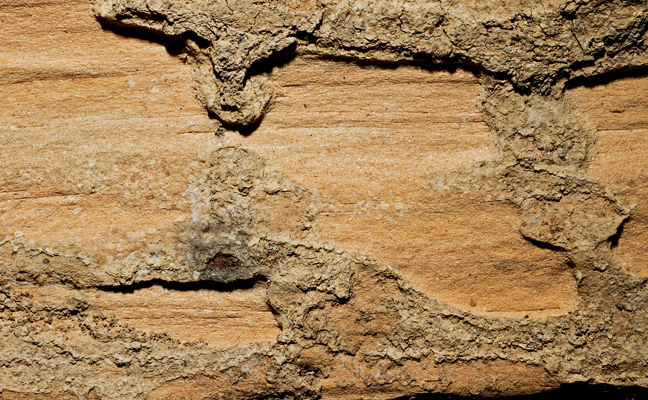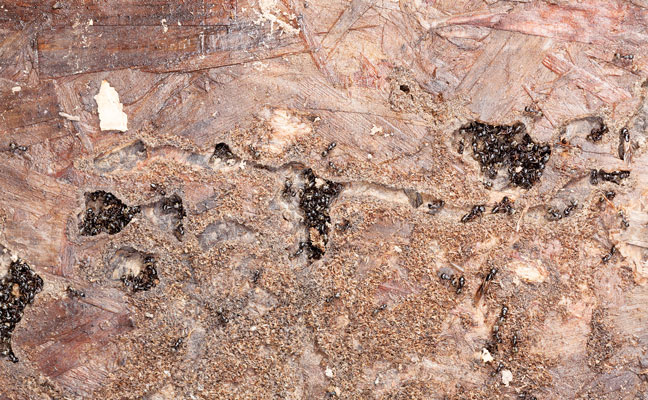Of all the pests that can inhabit an attic, wood-destroying insects (WDI) pose the most direct threat to a home’s structural integrity. While out of sight, a WDI infestation in the rafters, trusses, and sheathing can lead to thousands of dollars in damage.
For the pest management professional, identifying and controlling these pests in an attic requires a precise, technical approach. This article, part of our Top-floor tactics: The PMP’s ultimate guide to attic pest management, will examine the specific signs and control strategies for the two most common WDI found on the top floor: termites and carpenter ants.
Key takeaways
- Differentiate to treat: Proper identification is critical. Termites consume wood, leaving behind soil-filled galleries, while carpenter ants excavate it, leaving smooth, clean galleries and frass.
- Termites in attics: Subterranean termites in an attic indicate a well-established infestation that has traveled up from the ground, often via mud tubes.
- Carpenter ants & moisture: Carpenter ant activity in an attic is almost universally linked to a moisture problem, such as a roof leak. Solving the moisture issue is a critical part of control.
- WDI threat: Wood-destroying insects in an attic are a direct threat to a home’s structural integrity and require a precise, technical response.

Termites in the attic: A sign of serious infestation
Finding termites in an attic is a significant event. While drywood termites can establish primary colonies in attic timbers, the more widespread concern is finding subterranean termites this high up in a structure.
Because subterranean termites require contact with soil to survive, their presence in an attic means the infestation is well-established and has traveled up from the ground. They typically gain access by building mud tubes up the foundation and then moving through wall voids, along plumbing lines, or behind exterior siding to reach the attic.
Inspection cues for termites:
- Mud tubes: This is the hallmark sign of subterranean termites. In an attic, look for these earthen tubes on foundation walls, along rafters where they meet exterior walls, and around any pipe or chimney penetrations.
- Damaged wood: Termite-damaged wood has a distinct, layered appearance, as they consume the soft springwood and leave the harder summerwood behind. The galleries will contain soil and fecal matter, giving them a dirty appearance.
- Swarm evidence: Look for discarded wings around attic vents, windows, and light fixtures, which indicates a reproductive event (swarm) has occurred.
Treatment strategies for attic termite infestations:
- Confirm the source: The first step is a full structure inspection to identify the ground-level source of the infestation and all access points. An attic infestation is a symptom of a larger problem.
- Liquid soil treatment: The primary control method is typically a liquid termiticide treatment applied to the soil around the exterior foundation to create a continuous protective barrier.
- Direct wood treatment: Borate-based products can be applied directly to accessible attic timbers. This makes the wood toxic to termites and provides long-term residual protection.
- Baiting systems: Termite bait stations can be installed around the perimeter of the home. Above-ground bait stations can also be placed directly on activity in the attic to speed up colony elimination.

Carpenter ants: Excavators drawn to moisture
Unlike termites, carpenter ants do not eat wood. They excavate it to create nesting sites. Their presence in an attic is almost universally linked to a moisture issue. A roof leak, condensation from HVAC equipment, or a bathroom exhaust fan venting warm, moist air directly into the attic can soften wood and make it ideal for excavation. A parent colony is often located outside in a tree or stump, while satellite colonies are established inside the structure in these moisture-compromised areas.
Inspection cues for carpenter ants:
- Frass: This is the most definitive sign. Carpenter ant frass looks like coarse sawdust, often containing insect parts and other debris. Look for piles of it beneath rafters, on top of insulation, or near skylights.
- Smooth galleries: Carpenter ant galleries are clean and smooth, almost like they’ve been sandpapered. They will be free of the soil and mud found in termite galleries.
- Foraging trails: Observe for foraging ants, especially around dusk or dawn. They may be trailing from the attic down into the main living space.
- Sound: In a quiet attic, you can sometimes hear the faint sound of their chewing or movement within the wood.
Treatment strategies for attic carpenter ant infestations:
- Identify and correct the moisture source: This is the most critical step. No carpenter ant treatment will provide long-term success without fixing the underlying roof leak or ventilation issue.
- Locate the nest: Use the presence of frass and observations of trailing ants to pinpoint the nest location. A pyrethrin-based aerosol can be used to flush ants from suspected voids.
- Direct treatment: Once located, the nest can be treated directly with an appropriately labeled insecticidal dust or aerosol.
- Baiting and perimeter sprays: Using granular or gel baits can help control foraging ants and impact the broader colony. An exterior perimeter treatment with a non-repellent insecticide is also essential to prevent re-infestation.
Conclusion
Identifying and controlling wood-destroying insects in an attic environment requires a precise, technical approach. For the pest management professional, understanding the key differences between termites and carpenter ants — from the evidence they leave to the treatment strategies required — is essential to protecting a home’s structural integrity from the top down.
Leave A Comment